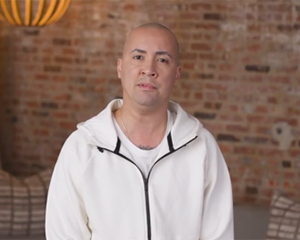(单词翻译:单击)
听力文本
JUDY WOODRUFF: Artist Angel Otero's brand of visual storytelling is a unique one. He pours paint onto glass and then peels it off in sheets once it dries. Tonight, Otero gives his Brief But Spectacular take on that process and how his roots help shape his work. It's also part of our Canvas series.

ANGEL OTERO, Artist: My name is Angel Otero. I grew up in the island of Puerto Rico, very working-class, middle-class family. My father was very pushy with the idea that I could follow his steps of being an insurance agent. And I did. I was a horrible salesman. I kept dreaming about being an artist, a painter. So I quit the job. On a Saturday morning, I remember telling him, like, hey, this school called the School of the Art Institute of Chicago saw my artwork. They offered me a scholarship to start studying painting. At a young age, I came across a book by Jackson Pollock. What I had learned as a child was that art has to be something that you recognize, that tells a story, all these things. And looking at images of this work felt very liberating and felt that they were paintings made with the idea of just the movement of painting and, you know, the physical part of it. Then, when making art in Chicago, I didn't know how to find my own voice. I had around my studio a big pile or a big mountain of dry oil paint that I didn't want to throw away. I decided that I wanted to collage it on the canvas. Most of the professors were kind of laughing at the ideas or think that I was coming up with saying that my paintings are about the warmth of Puerto Rico, about the Caribbean colors. That was when I started going back to those memories of growing up with my grandmother. And from there, I departed with the idea of composing all this imagery, collaging dry oil paint. I started having quite a good response to it. I started painting small pieces of glasses with different colors, scraping the paint off that glass, using those new skins to make new works. Some of those old stains of old colors that were in the glass were reflecting themselves on the new skins almost like print. I said, whoa, wait a minute, I can make a painting on a glass, and it can be figurative or abstract, and, eventually, I can paint another thing on top of it. The blurriness of how things change as our life changes over time is very interesting to me. My grandmother passed away four years ago. I know she would still not understand at all nothing of what I do, but it would have been very amazing to see her face or her thoughts about many of the works. My name is Angel Otero, and this is my Brief But Spectacular take on my body of work.
JUDY WOODRUFF: Very sweet. And you can find additional Brief But Spectacular episodes on our Web site, PBS.org/NewsHour/Brief.
重点解析
1.take on 呈现
Your music will take on different characteristics: playful, sad, perverse, pure, or whatever.
你的音乐将呈现不同的特性:顽皮、伤感、反常,纯净或者别的什么。
2.come across 无意中发现
He came across the jawbone of a 4.5 million-year-old marsupial.
他偶然发现了一个450万年前的有袋动物的颌骨。
3.liberating 感到释放的感觉
Some of the books he reviews find this symbiotic relationship depressing, but I find it liberating.
他所评论的一些著作认为这种共生关系令人压抑,但我觉得这让人解放。
4.figurative 形象的
The figurative language reinforces the reader's experience easily.
形象化的语言还易于加强读者的感受。
5.pass away 去世
She took her last walk in the garden and then passed away in sleep.
她在花园中散了最后一次步,然后就在睡眠中悄然离世了。
参考译文
朱迪·伍德拉夫:艺术家安吉尔·奥特罗讲述故事栩栩如生的方式独具一格。他把颜料倒在玻璃上,等颜料干了之后,把它剥落成一块一块的。今晚,奥特罗将在《简短而精彩》中分享他“讲故事”的过程以及他的根是如何帮助他塑造作品的。本期节目是帆布系列报道的部分内容。
安吉尔·奥特罗,艺术家:我是安吉尔·奥特罗。我在波多黎各岛上长大,我出身于工人阶级的中产家庭。我父亲曾经很固执地认为我可以追随他的脚步成为一名保险代理人。我也真地成了保险代理人,但我的销售业绩很差。成为一名艺术家或者说花架一直是我的梦想,于是,我辞掉了保险代理人的工作。某个周六的早上,我记得我跟父亲说了类似这样的话:嘿,老爸,芝加哥艺术学院发现我的作品了。他们愿意给我奖学金,让我学画画。我还小的时候,曾看过一本杰克逊·波洛克的作品。我小时候就学到了一件事——艺术必须是大家识别得出来的东西,必须要有故事这些要素。在观赏杰克逊·波洛克作品的时候,我感到自己得到了释放,我还感觉这幅画有动的感觉,是物理上的那种动。后来,我在芝加哥做艺术,我那时候不知道如何找到自己属于自己的特色。我的工作室附近堆着大量干了的油漆,我还不想丢掉。我决定了,我想把它们用在画布上。大多数教授都嘲笑我的观点或者认为我的画是想展现波多黎各的温暖感或者展现加勒比的各种色彩。也是那时候,我开始回溯跟祖母一起长大的回忆。也是从那时起,我就放弃了做这种画的念头,开始走上用干油漆作画的路。而且我做的时候也很喜欢。我开始用不同颜色的玻璃片作画,把颜料从玻璃上刮下来,换上新的皮来做新的作品。玻璃上一些陈旧颜色的渍迹在新皮上看起来跟印出来的一样。我说,哇哦,让我想想,原来我可以在玻璃上作画呀。这样做出来的画可以有丰富的含义,也可以颇为抽象。最后,我还可以在上面画点什么。随着时间的推移,不同物体变模糊的不同方式在我看来很有趣。4年前,我祖母去世了。我知道即便是现在,她可能也不知道我在做的是什么,但如果能看到她对我作品的反应和想法,那会是很棒的。我是安吉尔·奥特罗,这是我本期带来的与我作品有关的《简短而精彩》。
朱迪·伍德拉夫:很甜的分享。其他期节目可以在官网PBS.org/NewsHour/Brief上看到。
译文为可可英语翻译,未经授权请勿转载!


